Based on expert survivalists’ recommendations, I suggest checking out books like *Bushcraft 101*, *SAS Survival Handbook*, *Edible Wild Plants*, and *The Bushcraft Field Guide*. These guides cover essential skills from shelter building to edible plants, suited for beginners and seasoned adventurers alike. They include practical tips, visuals, and real-world techniques. To get the full picture and discover the top titles, keep exploring—I’ll share more details below.
Key Takeaways
- Expert survivalists recommend comprehensive guides like *SAS Survival Handbook* for versatility across wilderness and urban scenarios.
- Visual aids, clear instructions, and practical tips are crucial features valued by experts in top survival field guides.
- Foundational skills such as shelter, fire, water, and first aid are emphasized in recommended books for beginner and advanced users.
- Compact, durable formats suitable for field use are preferred by survivalists for quick reference and portability.
- Many experts favor guides that blend technical detail with real-life case studies and resource management strategies.
Bushcraft 101: Wilderness Survival Skills Guide

If you’re new to wilderness survival or want a practical, easy-to-follow guide, *Bushcraft 101: Wilderness Survival Skills Guide* by Dave Canterbury is an excellent choice. I find it well-organized and perfect for beginners, scouts, or outdoor enthusiasts. The book covers essential skills like shelter building, sourcing water, fire making, and resource conservation. Its clear, systematic approach makes complex concepts accessible, although it lacks some visual aids. I appreciate its focus on minimal gear, leveraging nature’s resources, and applying the “Five Cs of Survivability.” It’s a valuable resource for learning foundational skills and building confidence in the wilderness.
Best For: beginners, scouts, and outdoor enthusiasts seeking a practical, accessible guide to wilderness survival skills.
Pros:
- Well-organized and systematic, making complex skills easy to understand for beginners.
- Focuses on fundamental skills like shelter, water, fire, and resource conservation, suitable for most outdoor situations.
- Emphasizes minimal gear use and resourcefulness, aligning with modern bushcraft philosophies.
Cons:
- Lacks sufficient visual aids like illustrations or diagrams to aid comprehension for novices.
- The gear list includes high-end brands, which may be impractical or expensive for beginners.
- More of a reference guide than a trail-ready manual, less suitable for direct on-the-trail use.
SAS Survival Handbook, Third Edition

The SAS Survival Handbook, Third Edition, stands out as an essential resource for outdoor enthusiasts, survivalists, and anyone enthusiastic to build exhaustive survival skills. Written by John “Lofty” Wiseman, a former SAS soldier with 26 years of experience, it offers practical strategies for various scenarios and environments. The book covers everything from shelter building and signaling to health care and weather reading. With detailed illustrations and actionable advice, it emphasizes preparedness, mental resilience, and knowledge. Whether you’re in the wilderness or facing an emergency, this guide provides the tools and confidence needed to survive and thrive in any situation.
Best For: outdoor enthusiasts, survivalists, and anyone seeking comprehensive survival knowledge to handle emergencies and survive in various environments.
Pros:
- Extensive coverage of survival techniques across multiple scenarios and environments
- Rich with illustrations, real-life case studies, and practical advice for easy understanding
- Emphasizes mental resilience, preparedness, and essential skills for long-term survival
Cons:
- Small font size may be difficult to read for some users
- Limited use of color in illustrations could reduce visual clarity
- Heavy and bulky, which may impact portability during outdoor activities
Edible Wild Plants: A North American Field Guide to Over 200 Natural Foods
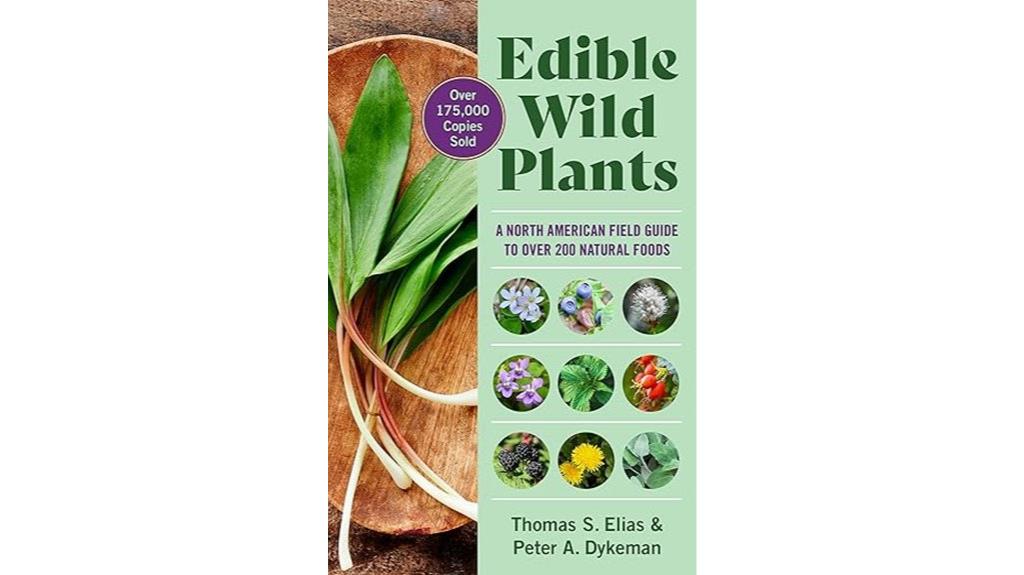
Edible Wild Plants: A North American Field Guide to Over 200 Natural Foods stands out as an essential resource for foragers and outdoor enthusiasts seeking detailed, reliable identification of wild edible and medicinal plants. It offers clear photographs, descriptions, and harvesting tips, making it easy to recognize plants in diverse environments. I appreciate its thoroughness, especially the guidance on preparation and habitat information. While some images are black-and-white, the overall clarity helps prevent mistakes. Whether you’re hiking, camping, or in a survival situation, this guide provides practical knowledge to safely find and use wild foods, making it a must-have reference for any outdoor adventurer.
Best For: outdoor enthusiasts, foragers, herbalists, and survivalists seeking a comprehensive and reliable guide to identify and utilize wild edible and medicinal plants across North America.
Pros:
- Extensive coverage of over 200 wild plants with detailed descriptions and practical harvesting tips
- Clear, colorful photographs enhance plant recognition in outdoor settings
- Useful for a wide range of activities including hiking, camping, and emergency survival situations
Cons:
- Some images are black-and-white, which may make identification more challenging in the wild
- Slightly confusing layout for seasonal organization of plants
- May be too detailed for casual or beginner users seeking quick reference
The Bushcraft Field Guide to Trapping, Gathering, and Cooking in the Wild
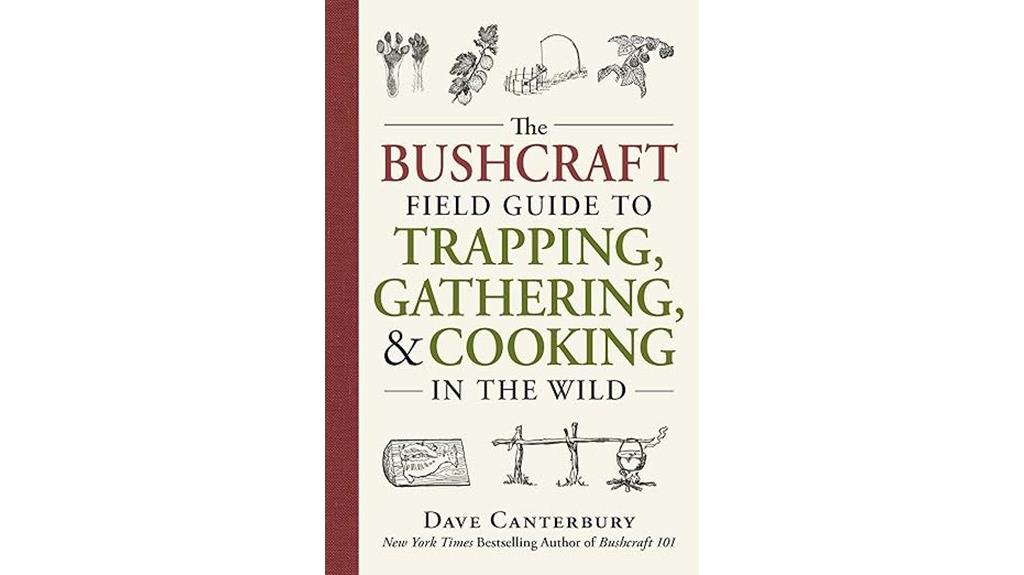
For outdoor enthusiasts eager to master primitive survival skills, *The Bushcraft Field Guide to Trapping, Gathering, and Cooking in the Wild* stands out as an essential resource. I appreciate how it simplifies complex techniques, making trapping, gathering, and primitive cooking accessible for beginners. The book’s clear instructions, supported by helpful illustrations and photos, make learning practical and effective. It covers crucial survival needs—food, water, shelter—focusing on real-world applications. Whether you’re camping or preparing for emergencies, this guide provides valuable skills you can trust. It’s a compact, affordable reference that boosts confidence in wild food sourcing and survival cooking.
Best For: outdoor enthusiasts, beginners, and survival-minded individuals seeking practical skills in trapping, gathering, and primitive cooking for camping or emergency preparedness.
Pros:
- Clear, easy-to-understand instructions supported by helpful illustrations and photos
- Focuses on fundamental survival needs—food, water, shelter—with real-world applications
- Compact and affordable, making it accessible and easy to carry for outdoor adventures
Cons:
- Some users reported arriving with minor damages, though the content remained valuable
- Not an exhaustive manual; requires practice for mastery of skills
- Basic presentation may be too simple for advanced survival practitioners seeking more in-depth techniques
Bushcraft First Aid: Wilderness Emergency Care Guide
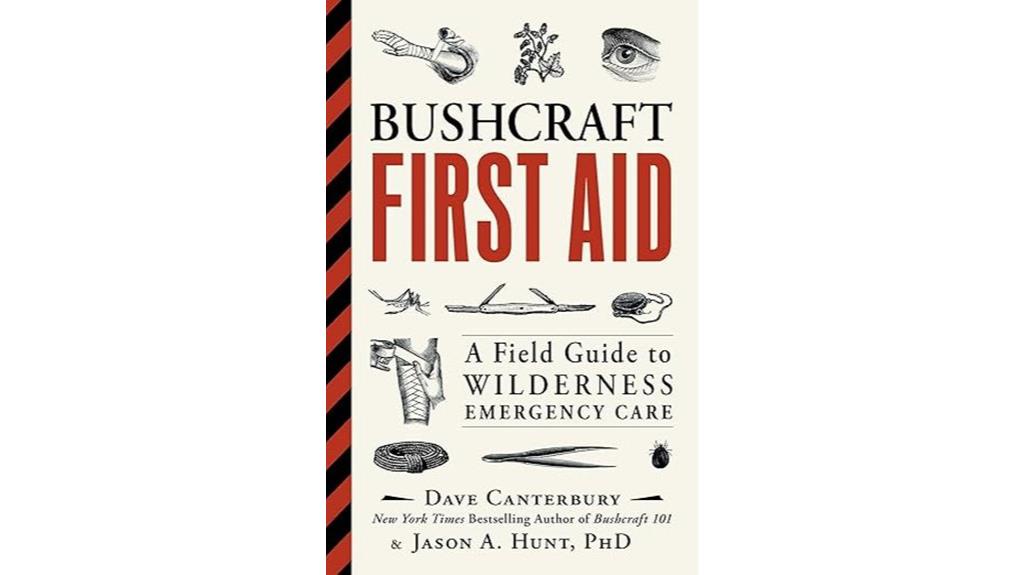
If you’re an outdoor enthusiast, prepper, or anyone venturing into remote wilderness areas, Bushcraft First Aid: Wilderness Emergency Care Guide stands out as an essential resource. It offers practical, easy-to-understand advice for handling injuries and emergencies in the wild, backed by real-world experience and expert input. The book covers a wide range of scenarios, from common injuries to life-threatening situations, with helpful photos of medicinal plants like pine needles. While it’s excellent for initial care and confidence-building, it offers limited guidance for extended emergencies, especially advanced procedures like suturing or infection control. Still, it’s a crucial addition to any wilderness survival library.
Best For: outdoor enthusiasts, preppers, and wilderness adventurers seeking a practical guide for emergency first aid in remote environments.
Pros:
- Clear, easy-to-understand instructions with practical tips and illustrative photos.
- Comprehensive coverage of common injuries and emergency scenarios to build confidence.
- Incorporates knowledge of medicinal plants and real-world applications for self-sufficiency.
Cons:
- Limited guidance on advanced medical procedures like suturing and infection control.
- Insufficient instructions for prolonged emergencies where professional help is unavailable.
- Lacks detailed follow-up actions for complex or life-threatening injuries beyond initial care.
Tiny Pocket Survival Guide EDC Reference Skills Field Emergency Disaster Rural Urban Preparedness

The Tiny Pocket Survival Guide is an essential tool for anyone who needs quick, reliable access to critical survival skills in both urban and rural settings. It covers problem-solving, shelter building, fire-starting, navigation, signaling, safety, and first aid, with formulas, conversions, and language tips to boost field readiness. Designed to be lightweight and water-resistant, it’s perfect for everyday carry and emergency use. Whether you’re in the city or the wilderness, this guide helps you respond rapidly to disasters, communicate effectively, and stay prepared with practical tools, knots, and resource info. It’s a compact, durable reference you can trust when every second counts.
Best For: outdoor enthusiasts, preppers, and emergency responders needing a compact, comprehensive survival reference for urban or rural environments.
Pros:
- Lightweight and water-resistant, making it durable and portable for everyday carry
- Covers a wide range of critical skills including shelter, fire, navigation, and first aid
- Includes practical tools, formulas, conversions, and language tips for field use
Cons:
- Limited space may restrict in-depth coverage of complex topics
- As a pocket-sized guide, it might require supplementary resources for advanced survival techniques
- May not be suitable for professional or highly specialized training needs
The Complete U.S. Army Survival Guide to Foraging
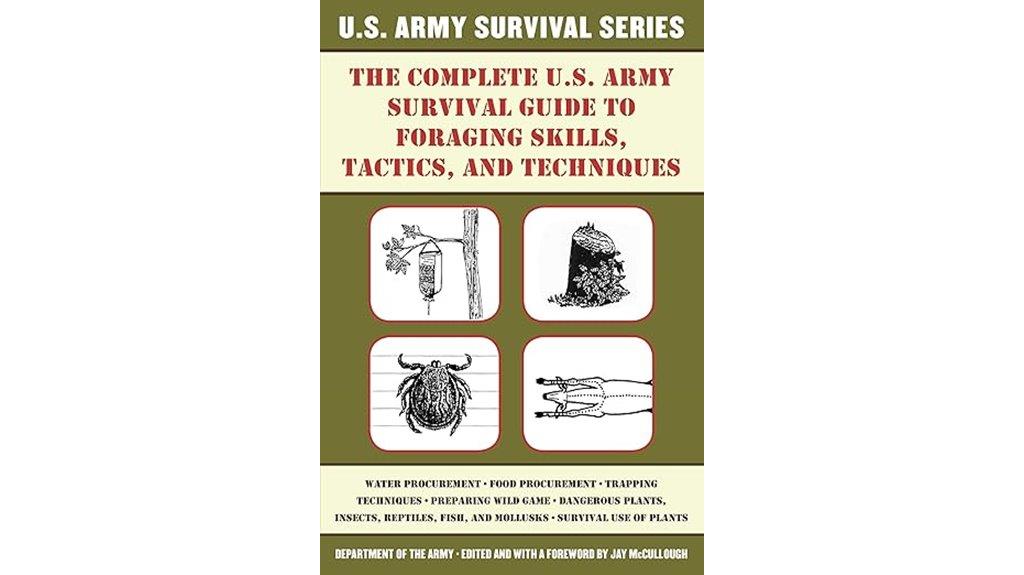
Designed for beginners and outdoor enthusiasts, The Complete U.S. Army Survival Guide to Foraging offers practical skills in bushcrafting, outdoor survival, and foraging. It provides detailed instructions suitable for those new to survival, focusing on basic tasks and techniques. The book is especially useful for preppers, outdoor lovers, and military enthusiasts interested in survival methods. While it’s packed with valuable information, some visuals are blurry, making wildlife identification challenging. Overall, it’s a solid resource for beginners, though advanced practitioners might find it repetitive or limited. I recommend it as a foundational guide to understanding essential foraging and survival techniques.
Best For: beginners, outdoor enthusiasts, and preppers seeking a practical, foundational guide to survival skills, bushcrafting, and foraging.
Pros:
- Offers detailed instructions suitable for those new to survival and outdoor activities
- Focuses on essential skills and techniques that are easy to understand
- Provides valuable information for preppers and military enthusiasts interested in survival methods
Cons:
- Visual aids are blurry and may hinder wildlife and plant identification
- Some content is repetitive or includes unnecessary military procedures for casual preppers
- The reproduction quality of images and illustrations could be improved for better learning
Preppers Long-Term Survival Guide
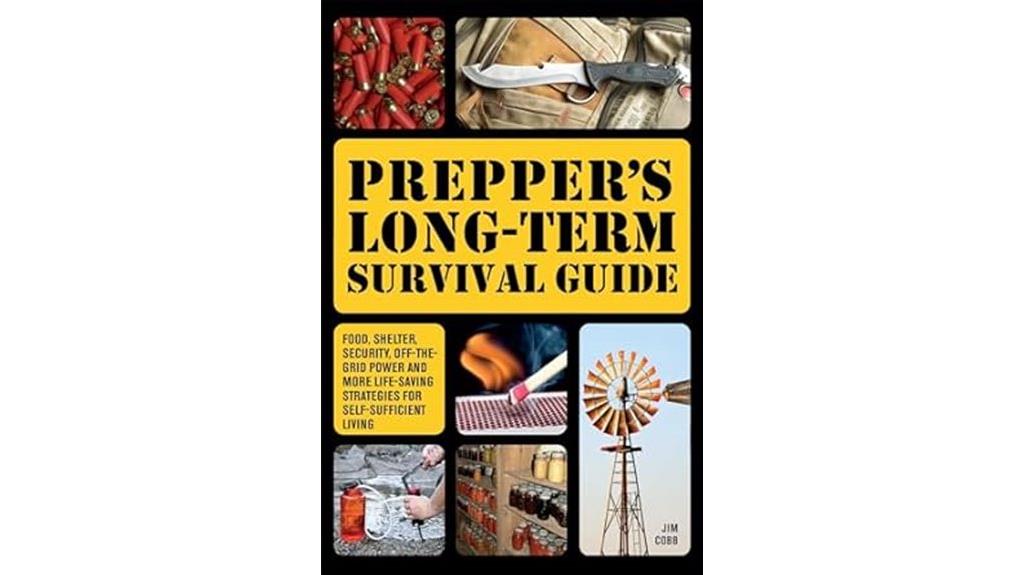
For those beginning their journey into long-term prepping, the “Preppers Long-Term Survival Guide” offers a practical and approachable roadmap. It emphasizes thinking beyond quick fixes, encouraging a mindset shift toward sustained, all-encompassing survival strategies. The book covers critical topics like food storage, medicine, security, off-grid power, and entertainment, all tailored for scenarios where modern comforts are gone for good. Rather than focusing solely on checklists, it helps you understand likely threats and how to prepare incrementally. Clear, accessible, and inspiring, this guide is perfect for newcomers or anyone wanting a broad overview to build confidence and develop a resilient long-term plan.
Best For: Beginners or preppers seeking a comprehensive, accessible overview of long-term survival strategies and mindset development.
Pros:
- Provides clear, practical guidance tailored for those new to long-term prepping
- Emphasizes a mindset shift and incremental planning beyond basic checklists
- Covers a broad range of topics, including food storage, medicine, security, and off-grid power
Cons:
- Lacks detailed, concrete instructions on food and water storage techniques
- Some content may be considered too gentle or general, especially regarding threats to women
- Not an exhaustive manual; focuses more on education and motivation than step-by-step procedures
Survival Hacks Book: Over 200 Ways to Use Everyday Items

If you’re someone with basic survival knowledge looking to maximize everyday items in emergency situations, the “Survival Hacks” book offers practical, easy-to-follow solutions. It covers over 200 hacks to extend your survival time, improve comfort, and repurpose common objects for critical needs. Organized into chapters on Shelter, Water, Fire, Food, and more, it provides quick tips and DIY projects, like making waterproof sacks or a slingshot from bike tubes. While lacking detailed visuals, the clear instructions make it accessible for beginners and moderate survivalists. This book is a handy resource to boost your confidence and creativity during emergencies.
Best For: beginners and moderate survivalists seeking practical, easy-to-implement hacks using everyday items to enhance emergency preparedness.
Pros:
- Offers over 200 accessible and inexpensive survival hacks suitable for various scenarios
- Clear, straightforward instructions that encourage hands-on practice and experimentation
- Covers a broad range of topics, including shelter, water, fire, and food, boosting overall confidence
Cons:
- Limited visual aids, making some projects difficult to visualize and execute
- Some tips are basic or redundant, lacking depth for advanced survival needs
- The black-and-white format and shipping issues may detract from the overall user experience
The Complete U.S. Army Survival Guide to Medical Skills, Tactics, and Techniques
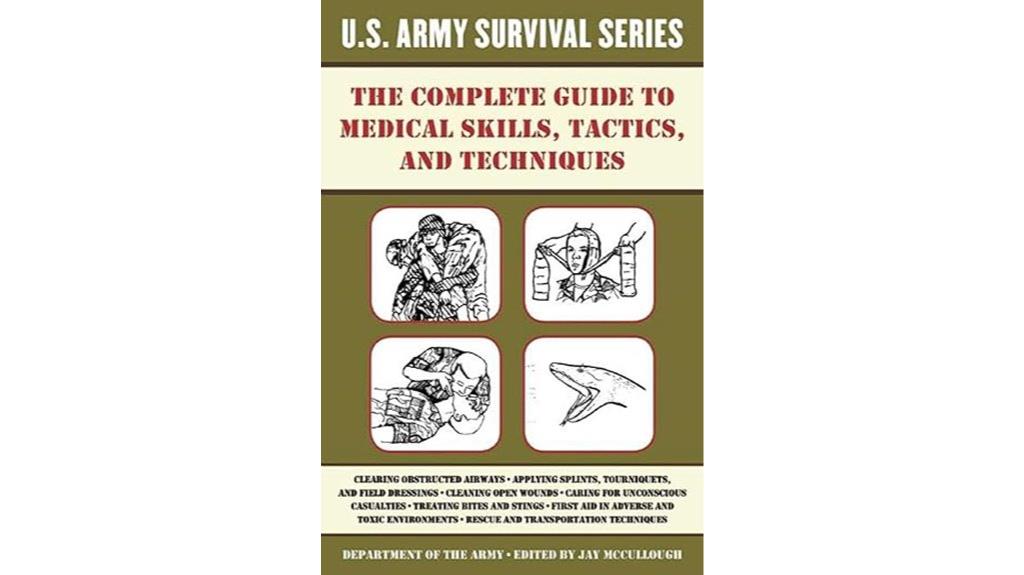
The Complete U.S. Army Survival Guide to Medical Skills, Tactics, and Techniques is a extensive resource for handling emergency injuries. It emphasizes trauma care, including stings, fractures, and climate-related injuries, with step-by-step instructions and practical tips. Designed for preppers, outdoor enthusiasts, and those serious about emergency prep, it offers military-grade techniques that focus on trauma management over symptom treatment. The visuals are simple black-and-white diagrams that help visualize procedures, though some may lack clarity. While thorough, some content feels outdated, and the dense information can be overwhelming. Still, it’s a valuable, affordable addition to any survival library.
Best For: preppers, outdoor enthusiasts, and individuals seeking comprehensive trauma-focused emergency medical training.
Pros:
- Provides detailed, step-by-step military-grade trauma management techniques.
- Covers a wide range of emergency scenarios with practical tips and cautions.
- Affordable and includes simple black-and-white visuals to aid understanding.
Cons:
- Some content appears outdated, reflecting older Army manuals.
- Dense information may lead to overload or difficulty in quick reference.
- Visuals are basic and may lack clarity, especially without color enhancements.
Off-Grid Survival Projects DIY Guide

Anyone interested in mastering practical skills for off-grid living will find the “Off-Grid Survival Projects DIY Guide” invaluable. It covers essential skills like shelter building, fire-starting, water filtration, and food preservation, all vital for self-sufficient living. You’ll learn how to create various shelters, DIY water filters, and fire-starting methods, including petroleum-soaked cotton balls. The guide also explains different solar panel types and how to build wind turbines, helping you generate your own power. Focused on the “Rule of Three”—shelter, water, and food—it empowers you to take control of your survival needs in remote, off-grid situations.
Best For: individuals seeking comprehensive, practical guidance on building off-grid survival skills, renewable energy solutions, and long-term self-sufficiency in remote environments.
Pros:
- Provides detailed, step-by-step instructions on shelter, water filtration, and food preservation techniques.
- Covers various renewable energy systems, including solar panels and wind turbines, promoting energy independence.
- Includes QR codes and a bibliography for further learning, making it accessible for beginners and advanced users alike.
Cons:
- May require additional research or materials for complex projects like wind turbine construction.
- Some skills, such as solar panel installation, might need prior technical knowledge for optimal implementation.
- The extensive scope could be overwhelming for those seeking quick, simple survival tips.
Wilderness Survival Guide: Practical Skills for the Outdoor Adventurer

Designed for outdoor enthusiasts of all skill levels, “Wilderness Survival Guide” stands out as a practical resource that combines clear instructions with visual aids. It’s compact, fitting easily into backpacks or emergency kits, and features checklists, diagrams, and illustrations that make complex skills accessible. Covering essentials like fire making, water sourcing, shelters, knots, and traps, it’s perfect for beginners and experienced adventurers alike. The straightforward layout, manageable chapters, and extra tips in yellow pages make quick reference easy. Many users praise its credibility, practicality, and user-friendly design, making it an invaluable companion for any outdoor trip or survival situation.
Best For: outdoor enthusiasts of all skill levels seeking a practical, easy-to-use survival reference for hiking, camping, hunting, or emergency preparedness.
Pros:
- Clear instructions with visual aids make complex skills accessible to beginners and seasoned adventurers alike
- Compact size and organized layout facilitate quick reference and easy packing for outdoor trips
- Comprehensive coverage including fire making, water sourcing, shelters, knots, and traps, backed by expert knowledge
Cons:
- Some users find certain trap-making instructions too brief or difficult to follow without additional research
- Offers general advice rather than in-depth technical details for advanced survival techniques
- Minor difficulty understanding specific sections may require supplemental resources for mastery
How to Survive the End of the World as We Know It Book

If you’re serious about preparing for worst-case scenarios, “How to Survive the End of the World as We Know It” by James Rawles stands out as an essential resource. It’s a detailed survival guide that covers everything from natural disasters to societal collapse, emphasizing resource stockpiling, self-sufficient living, and strategic retreats. Rawles pushes readers to think proactively, highlighting key steps like water and food storage, home security, and community reliance. While the advice can be dense and demanding, it offers a realistic blueprint for those committed to long-term preparedness. This book is invaluable for anyone wanting an all-encompassing, practical approach to surviving major crises.
Best For: individuals committed to comprehensive long-term disaster preparedness who are willing to invest time and resources into building self-sufficient lifestyles and strategic retreats.
Pros:
- Provides detailed, technical guidance on survival tactics and resource management.
- Emphasizes proactive planning and mental readiness for a variety of scenarios.
- Encourages community building and self-reliance as key components of resilience.
Cons:
- The dense, technical content can be overwhelming for beginners.
- Recommendations often require significant financial investment and lifestyle changes.
- Some strategies are tailored primarily for the U.S., limiting applicability in other regions.
Factors to Consider When Choosing Survival Field‑Guide Books
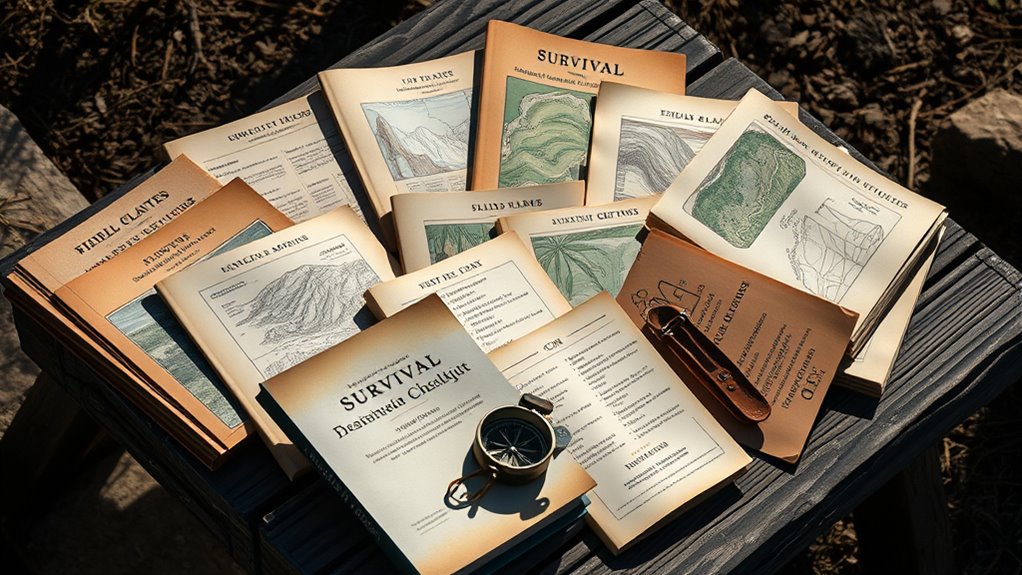
When choosing a survival field-guide, I look at how well it matches my skill level and covers different scenarios. I also consider how clear the visuals are and whether the instructions are easy to follow in real situations. finally, I think about what gear or resources I’ll need to put the advice into practice effectively.
Skill Level Suitability
Choosing a survival field-guide book that matches your skill level is essential to guarantee the information is both useful and manageable. If you’re a beginner, look for guides that focus on fundamental skills, using clear instructions, visuals, and simple language to make learning easier. These books should help you build a solid foundation without overwhelming you. For intermediate or advanced users, select guides that explore complex techniques, specialized scenarios, and advanced resource management, offering more technical depth. Also, consider whether the book is a quick reference or a comprehensive manual; beginners benefit from concise, easy-to-navigate guides, while more experienced survivalists might prefer detailed resources. Matching the content to your practical needs ensures you gain relevant skills without frustration.
Scenario Coverage Breadth
A well-rounded survival field guide should address a broad spectrum of scenarios, from wilderness emergencies to urban disasters and societal collapse. The scope of coverage impacts whether the book offers practical skills for immediate needs like shelter and fire, as well as advanced techniques for long-term survival such as sourcing food and medical care. It’s essential that the guide balances breadth and depth—covering enough detail to be useful without overwhelming the reader. Environmental factors like climate, terrain, and seasonal changes should also be included, since they influence survival strategies. Ultimately, the relevance of scenario coverage depends on your specific needs, whether you’re planning for wilderness adventures, urban crises, or off-grid living. Matching the book’s scope to your risks ensures you’re better prepared for whatever situation arises.
Visual Instruction Quality
Clear visual instructions are indispensable for effectively learning survival skills, especially for beginners who rely heavily on images and diagrams. High-quality visuals, like clear photographs and detailed illustrations, help you accurately identify plants, animals, and environmental features in real-world conditions. Poor or blurry images can lead to misinterpretation, increasing the risk of mistakes during critical tasks like trapping or foraging. Well-designed visual aids, including step-by-step photos or diagrams, simplify complex procedures, making skills easier to replicate under stress. If visuals are lacking or unclear, you’ll need to supplement your learning with videos or field apps to guarantee full understanding. Ultimately, good visual instruction enhances confidence and accuracy, making it a crucial factor when choosing a survival field guide.
Practical Application Ease
When selecting a survival field guide, I find it crucial that the instructions are clear, step-by-step, and accompanied by visual aids like diagrams or photos. This makes complex techniques easier to grasp quickly, especially under stress. I also prioritize books with a logical organization, so I can find information fast when seconds count. A practical guide should emphasize hands-on skills that don’t require complicated equipment, making techniques adaptable in real-world scenarios. Troubleshooting tips and alternative methods are essential, providing flexibility when standard procedures don’t work. Additionally, the book’s size, layout, and readability matter— it should be compact enough for field use without overwhelming or delaying me. Ease of application ensures I can act confidently when it matters most.
Gear and Resource Needs
Choosing a survival guide isn’t just about the techniques it covers but also about the gear and resources it recommends. I look for books that specify essential tools like knives, fire starters, and shelter materials, ensuring I can apply the advice practically. It’s important that the guide discusses sourcing, conserving, and managing resources, especially when supplies are limited. I also consider whether the book addresses gear needs for different environments, so I’m prepared for varied conditions. Clear guidance on the quality and affordability of equipment helps me balance practicality with my budget. Most importantly, I value resourcefulness tips that teach me how to make do with minimal gear. A good guide emphasizes resource management, helping me adapt when resources are scarce or unavailable.
Frequently Asked Questions
Which Survival Books Are Most Suitable for Urban Environments?
If you’re looking for survival books suited for urban environments, I recommend “Emergency: This Book Will Save Your Life” by Neil Strauss. It offers practical advice on steering through city emergencies, from blackouts to natural disasters. “Urban Survival Handbook” by David Nash is also great, providing strategies for shelter, water, and safety in crowded, built-up areas. These guides focus on real-world urban scenarios, helping you stay prepared and safe.
How Do I Evaluate the Credibility of a Survival Guide Author?
Imagine trusting a guide who’s only read a few blog posts—sounds chaotic, right? I check their credentials, real-world experience, and if they’ve been tested in actual survival situations. I also look for reviews from reputable survivalists and community feedback. If an author’s credentials are solid and they’ve demonstrated skills, I know I can rely on their advice—like having a trusted compass in a storm.
Are Digital Survival Guides Reliable During Emergencies?
Digital survival guides can be reliable during emergencies if they’re well-designed and stored offline. I always download essential guides onto my device beforehand, ensuring I can access them without internet. However, I keep printed copies just in case my tech fails. Relying solely on digital guides isn’t wise; having physical copies and practicing skills from these guides boosts my confidence and preparedness when it counts most.
Which Books Cover Long-Term Survival Planning Effectively?
If you’re looking for books that cover long-term survival planning effectively, I recommend “SAS Survival Handbook” by John “Lofty” Wiseman and “The Modern Survival Manual” by Fernando “Ferfal” Aguirre. These guides provide exhaustive strategies on sustainable living, resource management, and adapting over time. They’re practical, detailed, and written by experts, so I always keep one nearby for realistic, long-term prepping ideas that work in real-world scenarios.
How Do Cultural Differences Influence Survival Techniques in Guides?
I believe cultural differences profoundly shape survival techniques in guides because they reflect local knowledge, resources, and environmental challenges. For example, indigenous methods often emphasize sustainable practices tailored to specific ecosystems. I’ve seen how guides incorporating local customs and language are more practical and effective. This cultural integration ensures survival strategies are realistic, respectful, and adaptable, making them invaluable for diverse scenarios across different regions.
Conclusion
If you’re serious about survival, having the right guide can make all the difference. Did you know that 85% of survivalists say proper knowledge boosts their confidence in emergencies? These books cover essential skills, from foraging to first aid, giving you the tools to stay safe and resourceful. Investing in a top-rated field guide could be the best prep you make—because when disaster strikes, knowledge truly is your greatest asset.










